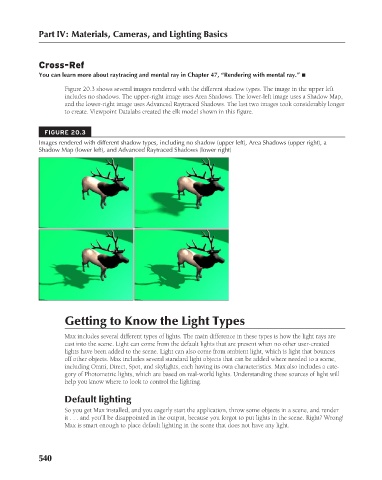Page 588 - Kitab3DsMax
P. 588
Part IV: Materials, Cameras, and Lighting Basics
Cross-Ref
You can learn more about raytracing and mental ray in Chapter 47, “Rendering with mental ray.” n
Figure 20.3 shows several images rendered with the different shadow types. The image in the upper left
includes no shadows. The upper-right image uses Area Shadows. The lower-left image uses a Shadow Map,
and the lower-right image uses Advanced Raytraced Shadows. The last two images took considerably longer
to create. Viewpoint Datalabs created the elk model shown in this figure.
FIGURE 20.3
Images rendered with different shadow types, including no shadow (upper left), Area Shadows (upper right), a
Shadow Map (lower left), and Advanced Raytraced Shadows (lower right)
Getting to Know the Light Types
Max includes several different types of lights. The main difference in these types is how the light rays are
cast into the scene. Light can come from the default lights that are present when no other user-created
lights have been added to the scene. Light can also come from ambient light, which is light that bounces
off other objects. Max includes several standard light objects that can be added where needed to a scene,
including Omni, Direct, Spot, and skylights, each having its own characteristics. Max also includes a cate-
gory of Photometric lights, which are based on real-world lights. Understanding these sources of light will
help you know where to look to control the lighting.
Default lighting
So you get Max installed, and you eagerly start the application, throw some objects in a scene, and render
it . . . and you’ll be disappointed in the output, because you forgot to put lights in the scene. Right? Wrong!
Max is smart enough to place default lighting in the scene that does not have any light.
540
6/30/10 4:26 PM
28_617779-ch20.indd 540
28_617779-ch20.indd 540 6/30/10 4:26 PM

